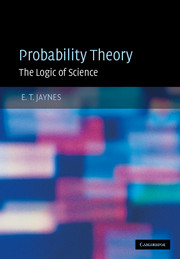Book contents
- Frontmatter
- Contents
- Editor's foreword
- Preface
- Part I Principles and elementary applications
- 1 Plausible reasoning
- 2 The quantitative rules
- 3 Elementary sampling theory
- 4 Elementary hypothesis testing
- 5 Queer uses for probability theory
- 6 Elementary parameter estimation
- 7 The central, Gaussian or normal distribution
- 8 Sufficiency, ancillarity, and all that
- 9 Repetitive experiments: probability and frequency
- 10 Physics of ‘random experiments’
- Part II Advanced applications
- Appendix A Other approaches to probability theory
- Appendix B Mathematical formalities and style
- Appendix C Convolutions and cumulants
- References
- Bibliography
- Author index
- Subject index
9 - Repetitive experiments: probability and frequency
from Part I - Principles and elementary applications
Published online by Cambridge University Press: 05 September 2012
- Frontmatter
- Contents
- Editor's foreword
- Preface
- Part I Principles and elementary applications
- 1 Plausible reasoning
- 2 The quantitative rules
- 3 Elementary sampling theory
- 4 Elementary hypothesis testing
- 5 Queer uses for probability theory
- 6 Elementary parameter estimation
- 7 The central, Gaussian or normal distribution
- 8 Sufficiency, ancillarity, and all that
- 9 Repetitive experiments: probability and frequency
- 10 Physics of ‘random experiments’
- Part II Advanced applications
- Appendix A Other approaches to probability theory
- Appendix B Mathematical formalities and style
- Appendix C Convolutions and cumulants
- References
- Bibliography
- Author index
- Subject index
Summary
The essence of the present theory is that no probability, direct, prior, or posterior, is simply a frequency.
H. Jeffreys (1939)We have developed probability theory as a generalized logic of plausible inference which should apply, in principle, to any situation where we do not have enough information to permit deductive reasoning. We have seen it applied successfully in simple prototype examples of nearly all the current problems of inference, including sampling theory, hypothesis testing, and parameter estimation.
Most of probability theory, however, as treated in the past 100 years, has confined attention to a special case of this, in which one tries to predict the results of, or draw inferences from, some experiment that can be repeated indefinitely under what appear to be identical conditions; but which nevertheless persists in giving different results on different trials. Indeed, virtually all application-oriented expositions define probability as meaning ‘limiting frequency in independent repetitions of a random experiment’ rather than as an element of logic. The mathematically oriented often define it more abstractly, merely as an additive measure, without any specific connection to the real world. However, when they turn to applications, they too tend to think of probability in terms of frequency. It is important that we understand the exact relationship between these conventional treatments and the theory being developed here.
Some of these relationships have been seen already; in the preceding five chapters we have shown that probability theory as logic can be applied consistently in many problems of inference that do not fit into the frequentist preconceptions, and so would be considered beyond the scope of probability theory.
- Type
- Chapter
- Information
- Probability TheoryThe Logic of Science, pp. 270 - 313Publisher: Cambridge University PressPrint publication year: 2003



